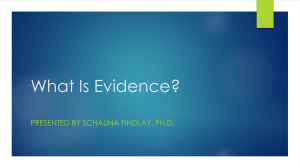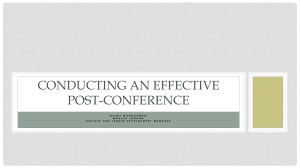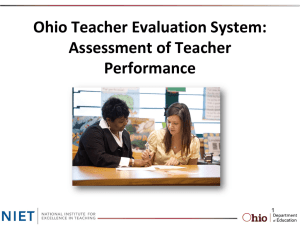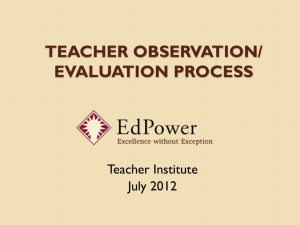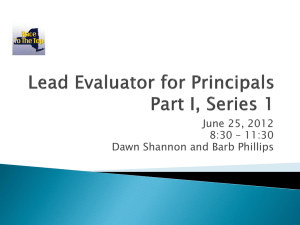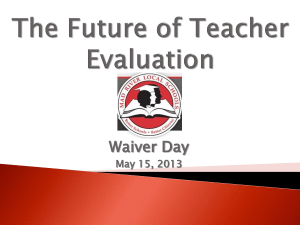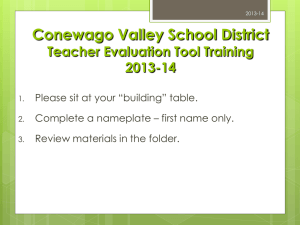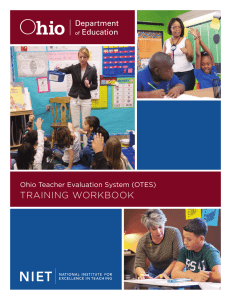Morning powerpoint on OTES
advertisement
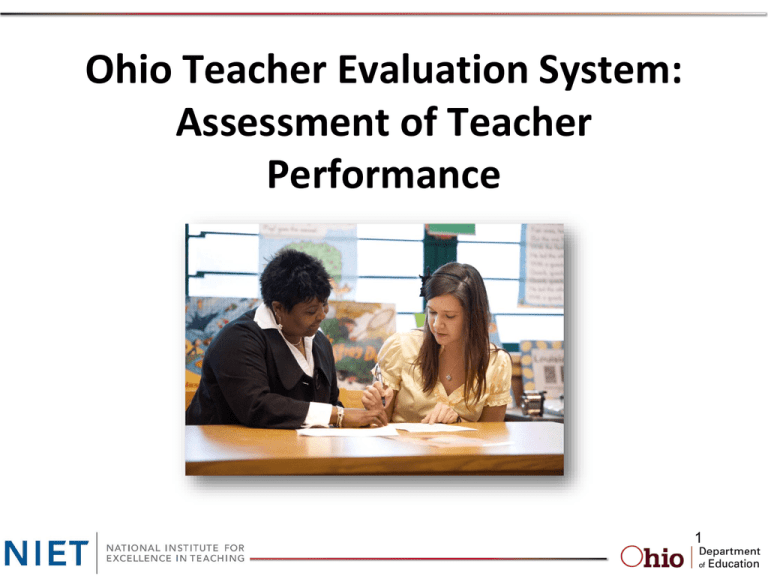
Ohio Teacher Evaluation System: Assessment of Teacher Performance 1 2 Training Purposes/Objectives • Understand and be able to apply the OTES Framework. • Be prepared to utilize the observation processes (pre-conference, observation, post-conference) presented from the Teacher Performance OTES framework component. • Understand and apply necessary tools from the OTES model • Understand and apply the evaluation rubric to personal classroom practice 3 Purpose “The (OTES) evaluation procedure is to be used for the improvement of instruction and learning with the teacher and evaluator working collaboratively in support of the teacher to achieve that goal.” 4 Text Rendering Purpose: To collaboratively construct meaning, clarify and expand our thinking about a text or document • Each table will be assigned a document that they need to render (count off by 6) A. “Professional Growth/Improvement Plan” (p. 63-64) B. “Implementing the OTES Process” (p.65-66) C. “Using the Evidence to Inform Holistic Performance Ratings” (p. 67-69) Text rendering asks you to dig deeply into the document as a group and define/describe what the most important information is 5 Text Rendering Set Up: Take 3-5 minutes to read the document your group has been assigned. After you are done reading: • Place a star next to the paragraph that you believe is most important • Underline the sentence within the paragraph that you think is most important H • Highlight the word that best captures the main point of the paragraph. Steps: P. 62 Go through steps 1-4 with your table group, and we will go through steps 5-6 as a large group 6 Present Your Text Rendering Findings • Each group will present their text rendering and the ‘big ideas’ they got from each document. 7 The Whole….. P. 70 and handout in pouch 8 The Part of our focus Today 9 Evaluation Documents (Prior to Formal Observation) Self Assessment Summary Professional Growth Plan pp. 27-28 1. Students 2. Content 3. Assessment 4. Instruction 5. Learning Environment 6. Collaboration and Communication 7. Professional Responsibility and Growth p. 29 • Annual Focus • Student Achievement Goal • Teacher Performance Goal 10 eTPES Electronic Portal • Teacher Evaluation System • Principal Evaluation System 11 Placemat Consensus 2 minutes to write individually Participant A 3 minutes to talk and reach consensus Participant B Consensus Elements Participant D Participant C 5 minutes to debrief When you walk out of a lesson that you deem to be effective, what were the elements that led you to that 12 decision? Whole School Consensus • Now that each group has come up with their own consensus, lets take a moment to make a whole school consensus • What is it that we would expect to see in a classroom that is deemed “effective”? 13 I. Instructional Planning a. Focus for Learning (Standard 4-Instruction) Sources of evidence to be provided by the teacher during pre-conference, supported by a discussion with the evaluator. b. Assessment Data (Standard 3-Assessment) Sources of evidence to be provided by the teacher during pre-conference, supported by a discussion with the evaluator. c. Prior Content Knowledge, Sequence, and Connections (Standard 1: Students; Standard 2: Content; Standard 4:Instruction) Sources of evidence to be provided by the teacher during pre-conference, supported by a discussion with the evaluator. d. Knowledge of Students (Standard 1: Students) An analysis of student data to be provided by the teacher during the pre-conference, supported by a discussion with the evaluator. II. Instruction and Assessment a. Lesson Delivery (Standard 2-Content; Standard4-Instruction; Standard 6: Communication) Sources of evidence demonstrated by the teacher and collected by evaluator during formal observation, classroom walkthroughs, and informal observations. b. Differentiation (Standard 1: Students; Standard 4: Instruction) Sources of evidence demonstrated by the teacher and collected by evaluator during formal observation, classroom walkthroughs, and informal observations. c. Resources (Standard 2: Content; Standard 4: Instruction) Sources of evidence demonstrated by the teacher and collected by evaluator during formal observation, classroom walkthroughs, and informal observations. d. Classroom Environment (Standard 1: Students; Standard 5: Learning Environment; Standard 6: Collaboration and Communication Sources of evidence demonstrated by the teacher and collected by evaluator during formal observation, classroom walkthroughs, and informal observations. e. Assessment of Student Learning (Standard 3: Assessment) Sources of evidence demonstrated by the teacher and collected by evaluator during preconference, formal observation, classroom walkthroughs, informal observations, and postconference. III. Professionalism a. Professional Responsibilities (Standard 6: Collaboration and Communication; Standard 7: Professional Responsibility and Growth) Sources of evidence included in the teacher’s Professional Development Plan or Improvement Plan; shared during the pre-conference and/or post-conference, and derived from daily interaction with others. 14 Instructional Planning OTES Rubric Structure FOCUS FOR LEARNING (Standard 4: Instruction) Sources of Evidence: Pre-Conference Ineffective Developing Proficient Accomplished The teacher does not have a clear focus for student learning or the objective is too general to guide lesson planning or the objective is inappropriate for the students. The teacher states a focus for student learning that is appropriate for students. The teacher develops a measurable objective for student learning that aligns with the Ohio standards. The teacher can explain the importance of the objective and its appropriateness for students. The teacher develops an ambitious and measurable objective for student learning that aligns with the Ohio standards. Teacher can explain how the objective fits into the broader unit and course goals for content learning and skills. 15 Rating 16 Instructional Planning Let’s dive into instructional planning: • Focus for Learning • Assessment Data • Prior Content Knowledge/Sequence/Connections • Knowledge of Students 17 Process of Modeling Your Thinking (Think-Aloud) I do Think Aloud We do Scaffold & Cue You do Students Explain Thinking 18 Rubric Activity Directions: Administrator/Trainer will model metacognition for highlighting key words from Knowledge of Students. 19 Knowledge of Students Assessment of Teacher Performance: OTES Rubric Proficient The teacher demonstrates familiarity with students’ background knowledge and experiences and describes multiple procedures used to obtain this information. The teacher’s instructional plan draws upon an accurate analysis of the students’ development, readiness for learning, preferred learning styles, and backgrounds and prior experiences. 20 Rubric Activity Directions: • As a table, discuss and highlight key words from the “Proficient” column for Focus for Learning, Assessment Data, Prior Content Knowledge/Sequence/Connections, and Lesson Delivery • For groups who finish early, go back to the Proficient column for these areas and note the differences from Developing and Accomplished. 21 I. Pre-Observation Conference Video clips: Clips next slide. Pre- Conference focus is on planning! Topics are: Instructional Planning • Focus for Learning • Assessment Data • Prior Content Knowledge/Sequence/Connections • Knowledge of Students 22 Video Clip 1 Pre – Conf- 52 Seconds Video Clip 2 Pre – Conf- Show 5 -7 minutes • http://www.nietbestpractices.org/OHIO/po rtals/0/tap%20library/articulate%20files/fo lder-724/document-199/player.html • http://www.nietbestpractices.org/OHIO/N avigation/VideoLibrary/LessonsbyGradeLe vel/5thGrade/tabid/897/Default.aspx • Log In Needed for Video 2 Check Notes 23 II. Instruction and Assessment • • • • • Lesson Delivery Differentiation Resources Classroom Environment Assessment of Student Learning 24 Rubric Activity Directions: • Individually, highlight key words from the “Proficient” column for Differentiation, Resources, Classroom Environment, and Assessment of Student Learning. • For those who finish early, go back to the Proficient column for these areas and note the differences from Developing and Accomplished. 25 When do you collect evidence? SCRIPTING Prior to the lesson being observed During the lesson After the lesson Pre-Conference •Review of lesson •Generate questions from lesson plan What the students What the teacher says and does say and do Post-Conference Communication between classroom observation and post-conference 26 Collecting/Capturing Evidence Capture: •What the teacher says •What the teacher does •What the students say •What the students do •Copy wording from visuals used during the lesson •Record time segments of lesson 27 Hints for Capturing Evidence When capturing evidence during the lesson, these strategies will help you collect accurate and defensible notes. 1. Time: Capture the length of different segments of the lesson 2. Abbreviate: When possible abbreviate; after the lesson write out what you abbreviated 3. Verbatim: Capture verbatim dialogue when possible 4. Paraphrase: Use parentheses to indicate paraphrasing 5. Circulate: Circulate as necessary to collect evidence from teacher, students and student work 28 Hints for Capturing Evidence When capturing and categorizing evidence after the lesson, these strategies may help you categorize effectively. 6. Label: Begin categorizing your notes by labeling evidence for rubric standard areas/indicators 7. Q & F: After you finish go thru your script and label all questions and feedback (Lesson Delivery and Assessment standards) 8. Upfront Summary: After you finish, go through the evidence and write a brief summary of the lesson 9. Lesson Analysis: Identify the lesson’s primary objective and sub-objectives (Focus for Learning) 29 Sample Evidence Collection Notes Sample Evidence Collection Notes Observing Classroom Instruction •We will view clips of classroom instruction and compare them to the rubric, Area: Instruction and Assessment. Remember to collect evidence from which you can validate your reasoning for placement on the rubric and assignment of a rating. 32 Instruction and Assessment • • • • • Lesson Delivery Differentiation Resources Classroom Environment Assessment of Student Learning 33 The Lesson Grade 4 LA Lesson http://nietbestpractices.org/OHIO/portals/0/tap%20librar y/articulate%20files/folder-745/document201/player.html Modules are short. Click on #9…if time show10 and 11… Show number 12 with evidence 34 Lesson 2 Choice HS Science http://www.nietbestpractices.org/OHIO/portals/0/tap%20 library/articulate%20files/folder-746/document200/player.html 35 Collecting and Categorizing Evidence: Language to Avoid Avoid the use of the following language: •Value Statements: • I think… •I feel… •She should have… •She could have… •When I taught this, I … The discussion about the lesson should be based on the evidence and the rubric. 36 Group Roles • Once you get to the group work, there are a few roles that need to be assigned: – “Holder of the handbook” • This person will make sure that we are interpreting each standard correctly, and answer any questions group members have about it. – “Keeper of the rubric” • This person will make sure that all conversations are about what the rubric asks for. Group Roles continued – “Value Judgment Police” • This person will make sure people do not use value judgment statements such as: – I would have… – She should have… – Timekeeper & Evidence Gatherer Debrief Evidence and Ratings •Whole group will debrief the evidence that was captured and the ratings that were given. 39 III. Professionalism How will you provide evidence for Professional Responsibilities? What evidence might an evaluator use to evaluate Professional Responsibilities? 40 Post-Observation Conference Purpose: To provide an opportunity for reflection on the areas of reinforcement and refinement from a lesson to inform and improve future practice. The post-observation conference should focus on two areas from the rubric (one for reinforcement and one for refinement). 41 Four Key Elements of the Instructional Post-Conference 1. 2. 3. 4. Introduction/Greeting Reinforcing the Teacher (Relative Lesson Strength) Refining the Teacher (Relative Lesson Weakness) Present Evidence and Rating Connected to the Rubric 42 Four Key Elements of the Instructional Post-Conference 1. Introduction/Greeting/Establish Length • Review Conference Process • General Impression Question - “How do you think the lesson went?” 2. Reinforcing the Teacher • Identify an area of Reinforcement (ONLY one area) • Ask Self-Analysis Question • Provide evidence from notes 43 Four Key Elements of the Instructional Post-Conference 3. Refining the Teacher’s Skill: • Identify an area of Refinement (ONLY one area) • Ask Self-Analysis Question • Provide evidence from notes • Give a recommendation for future practice 4. Present evidence and rating connected to the rubric 44 Post Confernce What Does it Look Like? • http://www.nietbestpractices.org/OHIO/po rtals/0/tap%20library/articulate%20files/fo lder-747/document-192/player.html 45 Wrap-Up and Questions ? 46
